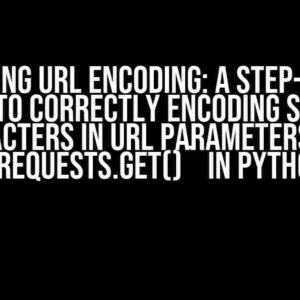Are you tired of staring at the cryptic error messages, wondering why your DiscreteMarkovChain model won’t cooperate in PyMC? Fear not, dear reader, for we’re about to embark on a thrilling adventure to tame this beast and get it working like a charm. Buckle up, and let’s dive into the world of Bayesian modeling!
What is DiscreteMarkovChain and Why Do I Need It?
In PyMC, DiscreteMarkovChain is a powerful tool for modeling discrete-time Markov chains. It’s a fundamental component for simulating complex systems, predicting outcomes, and understanding stochastic processes. If you’re working with categorical data, this model is your best friend. But, as you’ve discovered, getting it to work can be a real challenge.
The Problem: Common Issues with DiscreteMarkovChain
Before we dive into the solution, let’s acknowledge the common issues that might be driving you crazy:
- Initialization errors: “ValueError: The shape of the initial state must be (nstates,)”
- Transition matrix issues: “ValueError: The transition matrix must be a 2D array”
- Incompatible data types: “TypeError: Cannot broadcast array of shape (nstates,) to shape (nchains,)”
- Mysterious sampling errors: “SamplingError: Bad initial energy”
Take a deep breath; we’ll tackle each of these issues head-on.
Step 1: Gathering the Right Ingredients
Before building our DiscreteMarkovChain model, we need to prepare the necessary ingredients:
nstates: The number of states in our Markov chaintransition_matrix: A 2D array specifying the transition probabilities between statesinitial_state: The initial state distribution (optional)nchains: The number of chains to run in parallel (optional)
Let’s create a simple example to work with:
import numpy as np
nstates = 3
transition_matrix = np.array([[0.7, 0.2, 0.1],
[0.3, 0.5, 0.2],
[0.1, 0.4, 0.5]])
initial_state = np.array([0.4, 0.3, 0.3])
nchains = 2
Step 2:Initializing the DiscreteMarkovChain Model
import pymc as pm
with pm.Model() as model:
dmc = pm.DiscreteMarkovChain('dmc', n=nstates, p=transition_matrix)
Piece of cake, right? But wait, what about the initial state? That’s where things can get hairy…
Dealing with Initial State Issues
If you’re encountering initialization errors, it’s likely due to the shape of your initial state. Remember, the initial state should be a 1D array with shape (nstates,). Let’s fix our example:
initial_state = np.array([0.4, 0.3, 0.3])
with pm.Model() as model:
dmc = pm.DiscreteMarkovChain('dmc', n=nstates, p=transition_matrix, init_dist=initial_state)
Step 3: Defining the Model Structure
with model:
# Define a deterministic variable to store the transition matrix
transition_matrix_det = pm.Deterministic('transition_matrix_det', transition_matrix)
# Add a parameter to control the number of chains
nchains_param = pm.Poisson('nchains_param', mu=nchains)
This is where things can get a bit tricky. Make sure your transition matrix is a 2D array and your initial state is a 1D array.
Avoiding Transition Matrix Issues
print(transition_matrix.shape) # Should be (nstates, nstates)
Ensure that your transition matrix is a valid probability matrix, where each row sums to 1:
assert np.allclose(transition_matrix.sum(axis=1), 1)
Step 4: Sampling and Running the Chains
with model:
# Set up the step method
step = pm.Metropolis()
# Sample from the posterior
trace = pm.sample(1000, step=step, chains=nchains)
Voilà! You should now have a working DiscreteMarkovChain model in PyMC.
Troubleshooting Tips and Tricks
- Check your data types: Ensure that your transition matrix and initial state are numpy arrays.
- Verify your model structure: Double-check that your model is well-defined and the shapes of your variables match.
- Experiment with different step methods: Try using different step methods, such as pm.NUTS() or pm.HamiltonianMC(), to see if they resolve the issue.
- Consult the PyMC documentation: The PyMC documentation is an exhaustive resource for troubleshooting and understanding the library.
Conclusion
Congratulations, dear reader! You’ve made it through the treacherous landscape of DiscreteMarkovChain in PyMC. With these instructions and troubleshooting tips, you should be well-equipped to tackle even the most challenging Bayesian modeling tasks. Remember, practice makes perfect, so go forth and model those Markov chains like a pro!
| Ingredient | Description |
|---|---|
| nstates | The number of states in the Markov chain |
| transition_matrix | A 2D array specifying the transition probabilities between states |
| initial_state | The initial state distribution (optional) |
| nchains | The number of chains to run in parallel (optional) |
Happy modeling, and don’t hesitate to reach out if you have any further questions or need assistance!
Frequently Asked Question
Why is my DiscreteMarkovChain not sampling correctly in PyMC?
This could be due to the ordering of the transition matrix. In PyMC, the transition matrix should be ordered such that the rows correspond to the current state and the columns correspond to the next state. Make sure to double-check your transition matrix to ensure it’s correctly ordered.
How do I specify the initial state distribution in DiscreteMarkovChain?
You can specify the initial state distribution using the `p` parameter in the `DiscreteMarkovChain` constructor. For example, `pm.DiscreteMarkovChain(‘chain’, p=[0.5, 0.5], transition_matrix=Transition_Matrix)`. Here, `p` is a vector specifying the probability of each state at time 0.
Can I use a custom transition matrix in DiscreteMarkovChain?
Yes, you can! Simply pass your custom transition matrix to the `transition_matrix` parameter in the `DiscreteMarkovChain` constructor. For example, `pm.DiscreteMarkovChain(‘chain’, transition_matrix=my_transition_matrix)`.`
Why is my DiscreteMarkovChain model not converging?
Convergence issues can arise due to various reasons, such as poor initialization, inadequate tuning, or model misspecification. Try increasing the number of iterations, adjusting the tuning parameters, or reparameterizing your model to improve convergence. You can also use PyMC’s built-in convergence diagnostics to identify potential issues.
How do I visualize the results of my DiscreteMarkovChain model in PyMC?
You can use various visualization tools, such as ArviZ, Matplotlib, or Seaborn, to visualize the results of your DiscreteMarkovChain model. ArviZ, in particular, provides an excellent interface for visualizing Bayesian models, including DiscreteMarkovChain. Simply use `arviz.plot_trace` or `arviz.plot_forest` to visualize your model’s posterior distribution.




